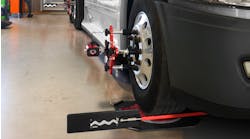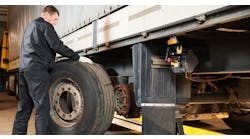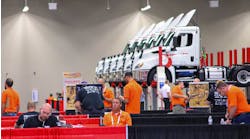Brake systems continue to represent the top reason for roadside inspection violations in the U.S. In fact, according to data from the Commercial Vehicle Safety Alliance (CVSA) International Roadcheck that took place in September 2020, brake system failures accounted for 25 percent of all vehicle-related out-of-service violations.
There is just no messing around when it comes to brake systems — especially air brake systems. Unfortunately, there are a lot of opportunities for problems to emerge. Technicians must remain on their toes, particularly with respect to system leaks.
Redline Detection is a manufacturer of diagnostic leak detection equipment. According to Mark Hawkins, head of technical products for Redline Detection, air brake leaks are becoming an even bigger issue for some fleets. That is why the Technology & Maintenance Council (TMC) has set up a task force to help address the issue.
“One of the big topics now is that some fleets have reported taking delivery of new vehicles that already have air leaks,” Hawkins said. “Sometimes it is a matter of things being assembled incorrectly, or maybe some components were not high-quality enough. Sometimes it is something simple like hoses not being cut correctly to make the perfect seal. That is the nature of the beast. Heavy duty trucks have always had leaks like this.”
According to Chuck Brodie, field service team leader for ZF Commercial Vehicle North America, air brake system leaks are generally not a problem — except for one potential issue.
“We don’t typically see any leaks at our valves unless there is a fitting issue,” Brodie pointed out. ZF is a technology company that supplies systems for cars, commercial vehicles, and industrial technology. ZF acquired WABCO Holdings in May 2020.
To Brodie’s point regarding fitting issues, technicians should always ensure that fittings are installed correctly and that air lines are carefully routed to avoid damage. Additionally, it is important to use care when diagnosing a leaking valve.
“Air coming out of the exhaust port of a valve doesn’t always indicate an issue with the valve,” Brodie said. “The air brake system leak could be originating from other places in the system such as the brake chamber.”
Hawkins said some of today’s heavy duty trucks have characteristics that make them more susceptible to a leak. Historically, main lines were heavy duty copper with threaded connections. Leaks rarely emerged unless rub-through occurred.
“Then things went to rubber to the brakes on the axles,” Hawkins said. “Fleets never really had a problem because everything had a good heavy duty connection and everything was still threaded between parts.”
Today, things have started to change. For speed of manufacturing, some OEs have gone to plastic with quick-coupler fittings. There are also large bundles of air lines because air is being supplied to not only the brakes, but also to the suspension and the cab, among other areas of the vehicle.
“Things just aren’t as robust as they used to be,” Hawkins related.
Richard Nagel, director of marketing and customer solutions for air supply and drivetrain at Bendix Commercial Vehicle Systems, said that whether a push-to-connect fitting is made of brass or nylon, it doesn’t always create the perfect seal. That can lead to small air leaks depending on the quality of the cut in the line.
“These fittings can also be highly susceptible to chemicals and temperature fluctuations,” Nagel pointed out.
Bendix is a developer of active safety technologies, air brake charging, and control systems for medium and heavy duty vehicles and trailers.
Corrosion is a major cause of leaks
Roadway surface treatments have also become a major cause for air brake system leaks. To help mitigate this issue, fleets should have strong inspection processes in place, as well as quality components that are designed to be up to the task.
“Some of the new de-icing treatments that are being used more regularly, like magnesium chloride, are causing a lot of corrosion issues,” Nagel said.
Technicians not only need a thorough winter-prep regimen for trucks and trailers, but also a post-winter regimen to look for any damage that may have emerged over the winter months.
The transition from winter to spring and into summer creates other potential corrosion-related issues for fleets. Nagel said the contrast of cold temperatures and heat coming off of the engine can spell trouble in the following ways:
- Trapped moisture due to freeze/thaw
- Humidity and moisture
- Metals expanding and contracting
- Plastics softening and hardening
Air lines, valves, and fittings aside, fleets must also pay close attention to their air system’s air dryer. Once again, corrosion can become a major issue — especially with respect to the seats around the purge and pressure protection valves, as well as the governor connection. Additionally, traditional steel air tanks can corrode and develop small punctures. Regular inspections should include a diligent search for signs of corrosion and cracking, along with breaks in any plastic air-line tubing that connects the air dryer to the air system.
Nagel says some air system component manufacturers have been working to address the corrosion issue. For instance, Bendix introduced its AD-HF Air Dryer in late 2019. It features a two-piece, high-strength aluminum casting with an integrated purge volume reservoir, which eliminates the need for a steel tank. Additionally, the primary housing is treated with an additional layer of corrosion protection.
Tips on finding and repairing leaks
According to Nagel, there are several warning signs that an air brake system may be experiencing a leak. For instance, the system may be charging more often than usual. The system may also be taking considerably longer to charge, such as three or four minutes as opposed to just one or two.
If it is suspected that an air leak may be occurring, technicians have their work cut out for them. Locating the leak (or leaks) is the first hurdle to overcome. Then the leak needs to be properly repaired.
Before any tractor-trailer can leave the lot, it should have an air brake leak-down test to ensure that it meets DOT standards.
“Testing will ensure that the brake system has not leaked down more than 5 psi in 60 seconds,” said Jeffrey Lerman, vice president of sales and marketing at Proflex+ Distribution, a developer of automotive diagnostic solutions including a lineup of smoke leak detectors. “If the tractor-trailer fails testing, you know you have a leak.”
Most of the time, Lerman explained, a failed leak test suggests that there is a ripped diaphragm in one of the service brake chambers, or that one of the valves is leaking. It could also be as simple as one of the hoses being cracked and leaking air. Regardless, pinpointing the leak is the challenge for a technician.
As Lerman explained, the old-school methods of simply looking and listening for signs of a leak or sometimes spraying soapy water to look for bubbles are not the most efficient.
“Today, when using a smoke leak-locating machine like the Smoke Monster Pro S 2000HD Heavy Duty, leaks can usually be found in about five minutes,” Lerman pointed out.
“To properly test air brakes, a technician will need at least 90 psi to find the leaks,” he continued. “In smoke mode, the smoke will exit the crack or hole in the affected area. After the technician makes the necessary repairs, they can verify that the repairs were done properly by switching the unit to the Air Leak Decay test to perform the secondary test to see that the pressure is holding and that the job was done correctly.”
Redline Detection offers a unique piece of equipment to help technicians locate air system leaks in a matter of minutes. Hawkins said this leak-detection procedure is also safe for the vehicle because no foreign substance is introduced into the brake system.
The NanoLeak Finder allows for easy connection to a vehicle’s main air-holding tank for the brake system. An automated, two-minute test is run to determine how much leak-down is occurring. If the system is losing more than 3 to 5 psi in 60 seconds, it is considered a failure. In the event of a failure, a technician simply pushes a button to initiate the next phase. The machine automatically pressurizes the air system with what Redline Detection refers to as “signature air,” which is created inside the machine using the shop’s regular compressed air.
The next step for the technician is to utilize the sniffing device to locate the leak(s).
“Our sniffing device is mapped exclusively to the signature air produced inside the machine,” Hawkins pointed out. “The process is similar to when searching for freon leaks in a vehicle’s AC system.”
With the NanoLeak Finder, a technician can start with a lower sensitivity setting, and then increase sensitivity to really pinpoint the location of even a small leak.
“Many fleets use this tool to perform regular inspections of a truck’s air system,” Hawkins said. “Technicians appreciate the automated test. They can push a button to start the test and then walk away to do something else. The automated system also removes any potential human error when searching for air leaks.”
Hawkins alluded to today’s modern heavy duty vehicles and the challenges they present to technicians.
“Beneath a heavy duty vehicle frame today, you have bundles of hoses and hundreds of connections,” Hawkins said. “Unless he or she can see or hear it, a technician really has no idea where a leak might be. With modern trucks, five or six pinhole leaks on various lines or connections can cause a large gross leak that results in a truck not passing inspection.”
ZF’s Brodie said the first step to efficiently repairing an air brake system leak is to accurately diagnose valve exhaust port leaks.
“During repair, make sure to install fittings and route lines according to the manufacturer recommendations,” Brodie pointed out. “Also, make sure to complete proactive maintenance like replacing air dryer cartridges annually and with original equipment to mitigate corrosion caused by moisture finding its way downstream.”
If addressing an air brake system leak requires the technician to cut the brake hose, Bendix’s Nagel said it is very important to make as precise a cut as possible.
“You don’t want a jagged cut or something at a 45-degree angle,” Nagel pointed out. “There are specialty tools out there to help make these brake line cuts. They are well worth the investment.”
Anything that can give technicians an advantage in finding air brake leaks is a good investment — especially considering how brake systems continue to be the top cause for roadside inspection failures.




